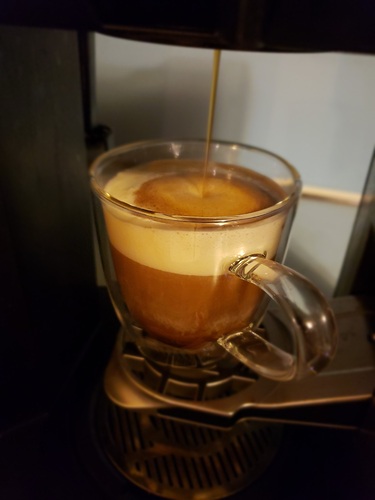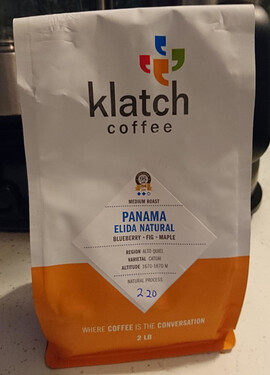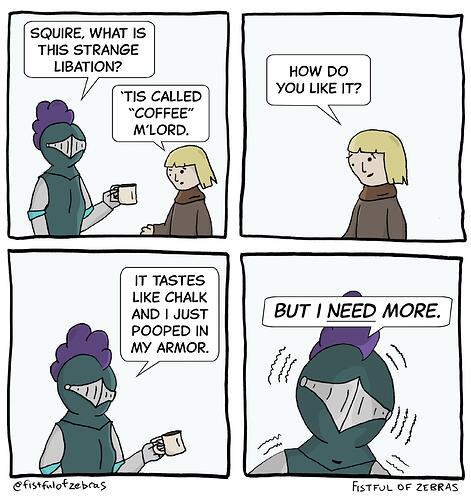The people who use it as their main brewer should weigh in but it’s quick, easy, consistent, and portable. One drawback is that it doesn’t make much coffee. Also depends on the flavor profile you’re going for. I wouldn’t press fruity or floral coffees, but medium to dark roasts with chocolate, spice, or nutty notes should do well.
It makes a concentrated cup that you’re supposed to cut with some hot water before drinking.
People swear by the Aeropress but I could never get a cup I liked out of mine so I gave it to my brother. This thread inspired me to pick up some dark Sumatran this weekend, looking forward to a French pressing it at some point.
That defeats the entire purpose of trying to do a good extraction though.
This thread made me want to start experimenting with specialty coffees again. Made an Almond Butter Mocha Latte today. Was delicious.
Is Nespresso considered really shitty by coffee aficionados here? I suck at coffee but addicted to caffeine so I just get my fix from my Nespresso machine. I tend to go for Apreggio (purple one).
I feel like Nespresso tastes pretty good for a single-serving machine although I haven’t had it in a while. Would not surprise me if it’s considered swill by aficionados though
It’s somewhere between instant and freshly ground beans.
I’ve only had Nespresso a couple of times but always got the vibe that it is the Keurig for people who think they are too good to be caught using a Keurig.
Alright finally got a chance to tear into this batch:
First up:
Panama Elida Natural Catuai from Klatch
Origin: Boquete, Panama (Elida Estate)
Roaster: Klatch
Roast: Medium
Varietal: Catuai
Process: Natural
Tasting notes: blueberry, fig, maple
Before my impression I want to give some background on this since it’s confusing. Panama is a special place for coffee mostly due to the geisha / gesha varietals that have been generally regarded (very recently) by coffee experts as the best and most interesting coffees in the world. If you want a detailed history of the variety in addition to pedantry regarding the correct spelling, you can find that in the article below. (I completely disagree with the author about the spelling).
As the article claims, the breakthrough for this was 2004 by the Panamanian coffee farm Hacienda la Esmeralda. Since then, a gesha lot produced by Elida Estate of Boquete, Panama, a farm owned by the Lamastus family, fetched the highest price ever at auction ($1,029/lb). This is a four-generation coffee operation and they strike me as being nothing but genuine and devoted to amazing coffee.
In the video, the grandfather jokes that he can’t afford to drink gesha daily but really enjoys the honey process catuai. Today I have the natural process catuai roasted by Klatch. This particular coffee received a high score on Coffee Review which is a rigged bullshit site but generally correct about coffees on their inflated 90+ range being pretty good.
That said, my impressions of this coffee are quite different as they often are from reviews I read online. There are plenty of reasons why that might be the case (brew technique, auction lot, palette, etc.).
I opted for my default grind setting and brewed through Chemex with filtered water right off boil. The fresh grounds were interesting and reminded me of pancakes and maple syrup. Drawdown seemed about right although I didn’t time it. Here’s the counter-clockwise spin during drawdown that’s a result of scraping the grounds off the sides and back into the slurry with a spoon in one circular pass after the pour is complete:

Impression: The main takeaway is that this tastes like tea to me–Earl Grey I suppose. I’m struggling to find the tasting notes listed by the roaster or in the CR review. What’s amazing is how the flavor profile changes in my mouth. Not sure I can describe the open, but the middle is acidic, just not overly so and definitely not sour. It’s lemony but complex. The finish, in contrast, is bitter, but in a pleasant way that I associate with quality loose leaf tea. Slight hint of maple syrup throughout. I can see how this might be an affordable “cousin” to gesha.
While this is very peculiar and tasty, it’s a bit outside my main coffee preference and probably a secondary or change of pace option for me. Don’t think I could mainline this but I’ll enjoy the next two weeks of it. I’d recommend it if you like both coffee and tea or if you are looking for something totally unique with a lot of flavors packed into one coffee. I’m going to mix up the brew parameters and see if I can get it to reveal anything different.
Kona always struck me as being the same kind of grift as Jamaican Blue Mountain. It’s basically just boring run-of-the-mill coffee but with some slick marketing as a kind of best kept secret that only coffee insiders know about, and, therefore pricey. At the very minimum, I’d want provenance on the estate and varietal if I was paying premium prices. For instance, most coffee sold as JBM might be as little as 10% real JBM cut with 90% garbage beans.
I’m extremely skeptical of the site you linked. There’s almost no information of the kind you’d expect to find from a legit coffee roaster. Most of it is dark roasted (over an open flame wtf?) which basically destroys any unique flavor profile the beans may have had. Not that CR is an end-all authority on coffee but I had a laugh:
Blind Assessment: Sweet and full-bodied with a hint of fruit, but aggressively flat, shallow, and bitter-toned. The almost total lack of acidity leaves the cup listless and prey to a sort of negative nuance: a soapy bitterness.
Who Should Drink It : Those who are so phobic about brisk, bright coffees that they are willing to sacrifice flavor to flatness.
There’s plenty of amazing coffee out of NorCal alone. Off the top of my head Equator Coffees in bay area and Verve in Santa Cruz.
Checking CR for Konas, there are definitely some high-rated ones, for instance:
But the thing is, this is just an SL-28 varietal grown in Hawaii and it’s like $130/lb. You can get a world-class SL-28 Kenyan for about $20/lb. Hawaii is arguably a worse place to grow it. I suspect all of their coffees are overpriced and you could find a coffee that’s at least as good in whatever flavor profile you desire for a fraction of the cost.
Should also point out that Hula Daddy is a CR advertiser (as well as Klatch) which is why I take all of their “reviews” with a truckload of salt. That said, I don’t think I’ve ever bought a coffee that I think they completely whiffed on.
What was the tasting procedure? Did they teach you cupping?
From what I’ve read, the best examples of Kona and JBM have been described as very smooth and balanced (read: not bitter) coffees. What I imagine is happening is North American coffee drinkers find them to be an “ideal” version of the flavorless, bitter coffee they’re used to. Although that doesn’t explain why JBM is so ridiculously popular in Japan, and I don’t think anyone’s ruled out the possibility there is some genetic PTC-type taste thing going on.
However, I think there’s maybe a second part to this which is smooth can mean non-acidic. So basically a low-acid coffee that’s not bitter but also interesting. It’s a tall order but the coffees that cover that ground are probably Brazilians, Ethiopians with nutty as opposed to fruity profiles, some Colombians that aren’t too acidic, and then anything that gets medium to dark roasted like Sumatran. There’s another one I’m forgetting that’s rare.
Edit: It’s this…
S&W Craft Roasting
Blue Mountain varietals from Papua New Guinea can be as good or better at easily 80% lower cost.
I’d say this is a general principle of coffee. Varietal type matters more than country of origin when controlling for other factors like roast and process as much as possible.
Good video on arabica varietals. I did not realize that Kona and JBM were just local versions of typicas.
When I was in law school I externed for a federal judge (basically worked as a law clerk instead of taking classes for a semester). One of the cases I worked on was a local foodee and wholesaler who was selling South American coffee as Kona coffee. He made a few million and got a couple of years in prison.
Ok ok, I guess I’ll go get one.
Are you using it as intended or with the inverted method? What’s your dialed in system look like?
No way that process can be easier than a bean to cup machine where you literally drop beans in and press a button.
I’m starting to wonder if maybe the best option for most people (for absolute top quality) is to invest in a vacuum sealer and order coffee ground by a good shop grinder. Divide it up into 3-4 day batches, vacuum those into small packs, freeze all but the current one. I guess it depends on what vacuum material costs and if it’s reusable.
See:
I think that would be fine for drip or press, but you have to be able to adjust the grind for espresso.




